Atkinson Morley's Hospital
Copse Hill, Wimbledon, SW20 0NE
Medical dates:
Medical character:
1867 - 2003
Convalescent. Later, neurological
Atkinson Morley's Hospital, built during 1867-69 as a convalescent home for patients recovering following treatment at St George's Hospital, Hyde Park, was the first such purpose-built facility to be associated with an inner city hospital.
Atkinson Morley, a former medical student, was the proprietor of the Burlington Hotel and one of
the Governors of St George's Hospital. When he died in 1858 he
left the Hospital £150,000 so that it would build its own
convalescent home in a quieter place (he had been disturbed by the
noise of traffic passing by outside while recovering from an operation
at the Hospital).
Prospect Place, a plot of land in Wimbledon which belonged to the
second Duke of Wellington, was purchased with the legacy and the
Atkinson Morley Convalescent Home opened in 1869. A large laundry
was also built on the site.
Patients and laundry from St George's Hospital were transported to
Wimbledon in two-horse drawn black closed carriages on Wednesday
afternoons. One in every six patients at St George's Hospital
convalesced at the Home.
In 1888 the horse drawn carriages were replaced by an 'omnibus',
purchased for 175 guineas (£183.75), which could transport 14
people.
In 1901 the ceiling of the children's ward collapsed. No-one was
injured but the other ceilings were found to be in a precarious state.
The Home was closed for repairs, during which time electricity
was installed. By 1908 more improvements had been made.
During WW1 the Home cared for servicemen.
In 1922, because of financial difficulties, the Home had to close for
three months to save money. Gradually over the years the purpose
of the Home changed, as it began to admit more acute cases and also
patients with TB. In 1939, however, the number of beds had to be
reduced to 74, again to cut costs.
During WW2 the Home was used for general acute work and was upgraded to
120 beds. Possil House (previously Ormond House) in a 3 acre site
at 23 Copse Hill was bought for £9000 for use as a Nurses' Home.
In 1942 the surgical wards were taken over for neurosurgery, and
the Home became the Atkinson Morley Emergency Hospital. In 1944 a
V1 flying bomb exploded nearby, but only a few windows were damaged.
After the war there was a major change of use for the Hospital, when it
became an internationally recognised neuroscience centre, treating head
injuries and patients needing neurosurgery. In 1949 the
Department of Psychiatry was established, as well as an X-ray
Department specializing in neuroradiology.
By 1954 the Hospital had 44 neurosurgical beds, 16 neurological and 50
psychiatric, with 14 beds available for continuity and recovery.
A Sleep Laboratory was established in 1972.
By the beginning of the 21st century the building was considered too
old and out-of-date. The Hospital closed in 2003 and services
transferred to the new neuroscience wing - Atkinson Morley Wing - on
the St George's Hospital campus at Tooting.
|
Present status ( March 2008) The Hospital buildings are
still there but dilapidated. Apparently the CT scanners are still
in situ, even though the Hospital is abandoned. |
|---|
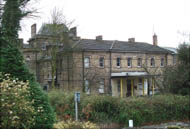
The main building.
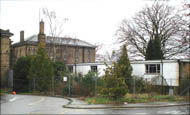
The main building and a Portakabin for 'Domestic services'.
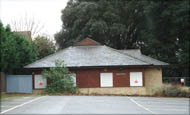
A pavilion at the eastern part of the site.
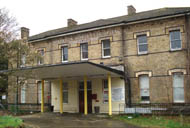
The main entrance with signage announcing that the Hospital has closed.
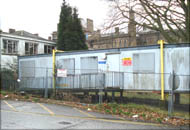
'Domestic services'.
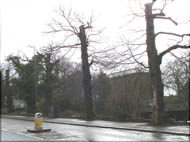
The former Hospital from the west on Copse Hill.

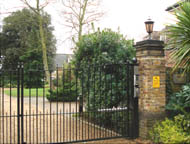
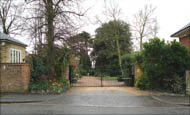
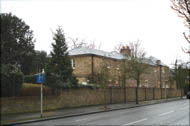
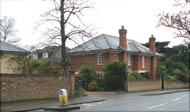
Prospect Place is now a gated development on Copse Hill. The only original building is the stable block, which has been extended as part of the redevelopment.
| Atkinson Morley Hospital was the first NHS Hospital to acquire a clinical CT scanner. In 1971 Godfrey Hounsfield, Head of the Medical Research Division at EMI, and the neuroradiologist Dr James Ambrose scanned their first patient, a woman with a suspected brain cyst. |
References
Bell BA 1996 Wylie McKissock - reminiscences of a commanding figure in British neurosurgery. British Journal of Neurosurgery 10, 9-18.
Gould T, Uttley D 1966 A History of the Atkinson Morley Hospital 1869-1995. London, Athlone.
Richmond C 2004 Obituary: Sir Godfrey Hounsfield. British Medical Journal 329 (7467), 687.
Ambrose E, Gould T, Uttley D 2006 Obituary: Jamie Ambrose. British Medical Journal 332 (7547), 977.
www.amhlung.org.uk
www.london.gov.uk
www.makingthemodernworld.org.uk
www.merton.gov.uk
www.stgeorges.nhs.uk
www.wimbledonmuseum.org.uk